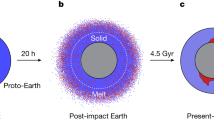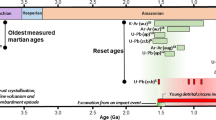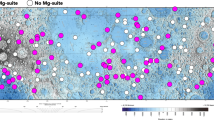Abstract
The asteroid 4 Vesta was recently found to have two large impact craters near its south pole, exposing subsurface material. Modelling suggested that surface material in the northern hemisphere of Vesta came from a depth of about 20 kilometres, whereas the exposed southern material comes from a depth of 60 to 100 kilometres. Large amounts of olivine from the mantle were not seen, suggesting that the outer 100 kilometres or so is mainly igneous crust. Here we analyse the data on Vesta and conclude that the crust–mantle boundary (or Moho) is deeper than 80 kilometres.
This is a preview of subscription content, access via your institution
Access options
Subscribe to this journal
Receive 51 print issues and online access
$199.00 per year
only $3.90 per issue
Buy this article
- Purchase on Springer Link
- Instant access to full article PDF
Prices may be subject to local taxes which are calculated during checkout



Similar content being viewed by others
References
Schenk, P. et al. The geologically recent giant impact basins at Vesta’s south pole. Science 336, 694–697 (2012)
Jutzi, M., Asphaug, E., Gillet, P., Barrat, J.-A. & Benz, W. The structure of the asteroid 4 Vesta as revealed by models of planet-scale collisions. Nature 494, 207–210 (2013)
Ivanov, B. A. & Melosh, H. J. 2D numerical modeling of the Rheasilvia impact formation. J. Geophys. Res. Planets 118, 1545–1557 (2013)
McCord, T. B., Adams, J. B. & Johnson, T. V. Asteroid Vesta: spectral reflectivity and compositional implications. Science 168, 1445–1447 (1970)
Ruzicka, A., Snyder, G. A. & Taylor, L. A. Vesta as the howardite, eucrite and diogenite parent body: implications for the size of a core and for large-scale differentiation. Meteorit. Planet. Sci. 32, 825–840 (1997)
Righter, K. & Drake, M. J. A magma ocean on Vesta: core formation and petrogenesis of eucrites and diogenites. Meteorit. Planet. Sci. 32, 929–944 (1997)
Mandler, B. E. & Elkins-Tanton, L. T. The origin of eucrites, diogenites, and olivine diogenites: magma ocean crystallization and shallow magma chamber processes on Vesta. Meteorit. Planet. Sci. 48 1–17 http://dx.doi.org/10.1111/maps.12135 (2013)
Toplis, M. J. et al. Chondritic models of 4 Vesta: implications for geochemical and geophysical properties. Meteorit. Planet. Sci. 16, 1–16 (2013)
Ammannito, E. et al. Vestan lithologies mapped by the visual and infrared spectrometer on Dawn. Meteorit. Planet. Sci. 48 1–14 http://dx.doi.org/10.1111/maps.12192 (2013)
De Sanctis, M. C. et al. Spectroscopic characterization of mineralogy and its diversity across Vesta. Science 336, 697–700 (2012)
McSween, H. Y. et al. Composition of the Rheasilvia basin, a window into Vesta’s interior. J. Geophys. Res. 118, 1–12 (2013)
Beck, A. W. et al. Challenges in detecting olivine on the surface of 4 Vesta. Meteorit. Planet. Sci. 48 1–11 http://dx.doi.org/10.1111/maps.12160 (2013)
McSween, H. Y. et al. Dawn; the Vesta-HED connection; and the geologic context for eucrites, diogenites, and howardites. Meteorit. Planet. Sci. 48, 2090–2104 (2013)
Binzel, R. P. & Xu, S. Chips off of asteroid 4 Vesta: evidence for the parent body of basaltic achondrite meteorites. Science 260, 186–191 (1993)
Bus, S. J. Evidence for spectral color variation within the Vesta family. In 8th Workshop on ‘Catastrophic Disruption in the Solar System’http://www.cd8.hawaii-conference.com/wp-content/uploads/2013/06/CD8_abs_Bus.pdf (2013)
Nesvorný, D. et al. Fugitives from the Vesta family. Icarus 193, 85–95 (2008)
Beck, A. W. & McSween, H. Y. Diogenites as polymict breccias composed of orthopyroxenite and harzburgite. Meteorit. Planet. Sci. 45, 850–872 (2010)
Mayne, R. G., Sunshine, J. M., McSween Jr, H. Y., Bus, S. J. & McCoy, T. J. The origin of Vesta’s crust: insights from spectroscopy of the Vestoids. Icarus 214, 147–160 (2011)
Reddy, V., Nathues, A. & Gaffey, M. J. First fragment of asteroid 4 Vesta’s mantle detected. Icarus 212, 175–179 (2011)
Buratti, B. J. et al. Vesta, vestoids, and the HED meteorites: interconnections and differences based on Dawn Framing Camera observations. J. Geophys. Res. 118, 1991–2003 (2013)
Park, R. S. et al. Gravity field expansion in ellipsoidal harmonic and polyhedral internal representations applied to Vesta. Icarus http://dx.doi.org/10.1016/j.icarus.2013.12.005 (in the press)
Greenwood, R. C. et al. The oxygen isotope composition of diogenites: evidence for early global melting on a single, compositionally diverse, HED parent body. Earth Planet. Sci. Lett. 390, 165–174 (2014)
Barrat, J.-A., Yamaguchi, A., Zanda, B., Bollinger, C. & Bohn, M. Relative chronology of crust formation on asteroid Vesta: insights from the geochemistry of diogenites. Geochim. Cosmochim. Acta 74, 6218–6231 (2010)
Yamaguchi, A., Barrat, J.-A., Ito, M. & Bohn, M. Posteucritic magmatism on Vesta: evidence from the petrology and thermal history of diogenites. J. Geophys. Res. 116, E08009 (2011)
Ammannito, E. et al. Olivine in an unexpected location on Vesta’s surface. Nature 504, 122–125 (2013)
Tera, F., Eugster, O., Burnett, D. S. & Wasserburg, G. J. Comparative study of Li, Na, K, Rb, Cs, Ca, Sr and Ba abundances in achondrites and in Apollo 11 lunar samples. Proc. Apollo 11 Lunar Sci. Conf. 2, 1637–1657 (1970)
Hans, U., Kleine, T. & Bourdon, B. Rb–Sr chronology of volatile depletion in differentiated protoplanets: BABI, ADOR and ALL revisited. Earth Planet. Sci. Lett. 374, 204–214 (2013)
Clénet, H. et al. A new systematic approach using the Modified Gaussian Model: insight for the characterization of chemical composition of olivines, pyroxenes and olivine–pyroxene mixtures. Icarus 213, 404–422 (2011)
Russell, C. T. et al. Dawn at Vesta: testing the protoplanetary paradigm. Science 336, 684–686 (2012)
De Sanctis, M. C. et al. The VIR spectrometer. Space Sci. Rev. 163, 329–369 (2011)
Anderson, J. et al. Isis cartographic tools for the Dawn Framing Camera and Visual and Infrared Spectrometer. AGU Fall Meet. Abstr. U31A–0009 (American Geophysical Union, 2011)
Reddy, V. et al. Color and albedo heterogeneity of Vesta from Dawn. Science 336, 700–704 (2012)
De Sanctis, M. C. et al. Vesta’s mineralogical composition as revealed by the visible and infrared spectrometer on Dawn. Meteorit. Planet. Sci. 48 1–19 http://dx.doi.org/10.1111/maps.12138 (2013)
Li, J.-Y. et al. Photometric properties of Vesta. In Asteroids, Comets, Meteors Conf. (eds Li, J.-Y. et al.) abstr. 6387. (2012)
Adams, J. B. Visible and near IR diffuse reflectance spectra of pyroxenes as applied to remote sensing of solid objects in the solar system. J. Geophys. Res. 79, 4829–4836 (1974)
Singer, R. B. Near-infrared spectral reflectance of mineral mixtures: systematic combinations of pyroxenes, olivine and iron oxides. J. Geophys. Res. 86, 7967–7982 (1981)
Cloutis, E. A. & Gaffey, M. J. Spectral-compositional variations in the constituent minerals of mafic and ultramafic assemblages and remote sensing implications. Earth Moon Planets 53, 11–53 (1991)
Sunshine, J. M., Pieters, C. M. & Pratt, S. F. Deconvolution of mineral absorption bands: an improved approach. J. Geophys. Res. 95, 6955–6966 (1990)
Sunshine, J. M. & Pieters, C. M. Estimating modal abundances from the spectra of natural and laboratory pyroxene mixtures using the modified Gaussian model. J. Geophys. Res. 98, 9075–9087 (1993)
Sunshine, J. M. & Pieters, C. M. Determining the composition of olivine from reflectance spectroscopy. J. Geophys. Res. 103, 13675–13688 (1998)
Kanner, L. C., Mustard, J. F. & Gendrin, A. Assessing the limits of the Modified Gaussian Model for remote spectroscopic studies of pyroxenes on Mars. Icarus 187, 442–456 (2007)
Clenet, H. Télédétection hyperspectrale: minéralogie et pétrologie, application au volcan Syrtis Major (Mars) et à l’ophiolite d'Oman. PhD thesis, Univ. Toulouse, http://thesesups.ups-tlse.fr/501/ (2009)
Clenet, H., Isaacson, P. J. & Gillet, P. Systematic mapping of mafic minerals in the Copernicus region, the Moon: an improved approach based on Modified Gaussian Model applied to M3 data. Lunar Planet. Sci. Conf. 1822, (2014)
Clenet, H. et al. A systematic mapping procedure based on the Modified Gaussian Model to characterize magmatic units from olivine/pyroxenes mixtures: application to the Syrtis Major volcanic shield on Mars. J. Geophys. Res. 118, 1632–1655 (2013)
Beck, P. et al. NIR spectral trends of HED meteorites: can we discriminate between the magmatic evolution, mechanical mixing and observation geometry effects? Icarus 216, 560–571 (2011)
Acknowledgements
M.J. acknowledges support from the Swiss National Science Foundation through the Ambizione program. J.-A.B. acknowledges support from the INSU Programme National de Planétologie. E.I.A. was sponsored by the NASA Planetary Geology and Geophysics Program.
Author information
Authors and Affiliations
Contributions
H.C. analysed data and led the research. M.J. performed the numerical simulations. P.G. initiated the collaboration and funded part of the research. All authors interpreted the results and contributed to the preparation of the manuscript.
Corresponding author
Ethics declarations
Competing interests
The authors declare no competing financial interests.
Extended data figures and tables
Extended Data Figure 1 Olivine-diogenite spectra and MGM result for NWA4223.
Olivine–diogenite spectra from meteorites NWA5480 and NWA4223 (57% and 50% olivine respectively) and comparison with a spectrum from diogenite Tatahouine (orthopyroxenite). Spectra are represented in reflectance space (a) and with the continuum removed (b) for visual comparison of the shape of the absorption. The MGM result for the NWA4223 spectrum is represented in c. The parameters (from left to right the centre, width and strength are shown) for each Gaussian function (three for olivine and two for orthopyroxene), the continuum and the residual (root mean square, RMS) are reported. Olivine and pyroxene are both correctly detected. Opx, orthopyroxene; Ol, olivine.
Rights and permissions
About this article
Cite this article
Clenet, H., Jutzi, M., Barrat, JA. et al. A deep crust–mantle boundary in the asteroid 4 Vesta. Nature 511, 303–306 (2014). https://doi.org/10.1038/nature13499
Received:
Accepted:
Published:
Issue Date:
DOI: https://doi.org/10.1038/nature13499
This article is cited by
-
A model of crust–mantle differentiation for the early Earth
Acta Geochimica (2022)
-
Olivine-rich achondrites from Vesta and the missing mantle problem
Nature Communications (2021)
-
Mesosiderite formation on asteroid 4 Vesta by a hit-and-run collision
Nature Geoscience (2019)
-
Effect of temporary resonance with heterogeneous Itokawa
Astrophysics and Space Science (2018)
-
Non-destructive characterisation of the Elephant Moraine 83227 meteorite using confocal Raman, micro-energy-dispersive X-ray fluorescence and Raman-scanning electron microscope-energy-dispersive X-ray microscopies
Analytical and Bioanalytical Chemistry (2018)
Comments
By submitting a comment you agree to abide by our Terms and Community Guidelines. If you find something abusive or that does not comply with our terms or guidelines please flag it as inappropriate.



